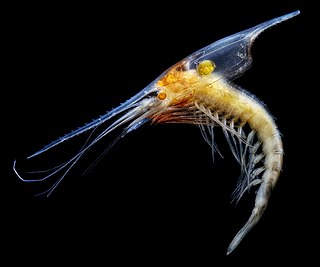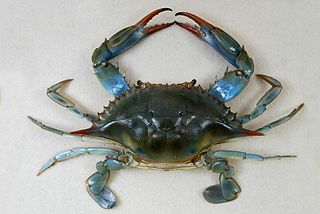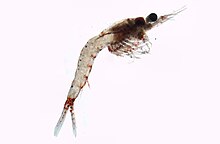
Malacostraca is the second largest of the six classes of crustaceans just behind hexapods, containing about 40,000 living species, divided among 16 orders. Its members, the malacostracans, display a great diversity of body forms and include crabs, lobsters, crayfish, shrimp, krill, prawns, woodlice, amphipods, mantis shrimp, tongue-eating lice and many other less familiar animals. They are abundant in all marine environments and have colonised freshwater and terrestrial habitats. They are segmented animals, united by a common body plan comprising 20 body segments, and divided into a head, thorax, and abdomen.

Mysida is an order of small, shrimp-like crustaceans in the malacostracan superorder Peracarida. Their common name opossum shrimps stems from the presence of a brood pouch or "marsupium" in females. The fact that the larvae are reared in this pouch and are not free-swimming characterises the order. The mysid's head bears a pair of stalked eyes and two pairs of antennae. The thorax consists of eight segments each bearing branching limbs, the whole concealed beneath a protective carapace and the abdomen has six segments and usually further small limbs.

Eucarida is a superorder of the Malacostraca, a class of the crustacean subphylum, comprising the decapods, krill, and Angustidontida. They are characterised by having the carapace fused to all thoracic segments, and by the possession of stalked eyes.

Lophogastrida is an order of malacostracan crustaceans in the superorder Peracarida, comprising shrimp-like animals that mostly inhabit the relatively deep pelagic waters of the oceans throughout the world.

The superorder Peracarida is a large group of malacostracan crustaceans, having members in marine, freshwater, and terrestrial habitats. They are chiefly defined by the presence of a brood pouch, or marsupium, formed from thin flattened plates (oostegites) borne on the basalmost segments of the legs. Peracarida is one of the largest crustacean taxa and includes about 12,000 species. Most members are less than 2 cm (0.8 in) in length, but the largest is probably the giant isopod which can reach 76 cm (30 in). The earliest known perecaridian was Oxyuropoda ligioides, a fossil of which has been found dating to the Late Devonian of Ireland.
Phliantidae is a family of isopod-like amphipod crustaceans chiefly from the southern hemisphere.

Eumalacostraca is a subclass of crustaceans, containing almost all living malacostracans, or about 40,000 described species. The remaining subclasses are the Phyllocarida and possibly the Hoplocarida. Eumalacostracans have 19 segments. This arrangement is known as the "caridoid facies", a term coined by William Thomas Calman in 1909. The thoracic limbs are jointed and used for swimming or walking. The common ancestor is thought to have had a carapace, and most living species possess one, but it has been lost in some subgroups.

Nannastacidae is a family of crustaceans belonging to the order Cumacea. They have no free telson. The endopods of the uropods are present on one segment. There are exopods on the maxillipeds and generally one on pereopods 1–4 in males and 1–2 in females. In the females the second antenna is much shorter than the first. It contains the following genera:
Edriophthalma is a disused peracarid (Malacostraca) classification comprising Isopoda and Amphipoda, first proposed by William Elford Leach in 1815. They have several common features, such as the fact that they both lack a carapace, possess sessile compound eyes, and thoracic coxae fused to their pleurites. Some molecular studies have shown that these are not related. The group has also been known as Acaridea and Arthrostraca.

Paramysis is a genus of mysid crustaceans (Mysidacea) in family Mysidae, distributed in coastal zone of low boreal East Atlantic Ocean, Mediterranean Sea and the basins of Black Sea, Sea of Azov and Caspian Sea.

Gnathophausia zoea is a species of lophogastrid crustacean. It is widely distributed in the Atlantic Ocean from the Arctic Circle to the Equator; in the Pacific Ocean, it is more restricted to tropical areas. The adults may reach 40–50 millimetres (1.6–2.0 in) long, excluding the rostrum, or around 70 mm (2.8 in) including the rostrum.
Phylogeny of Malacostraca is the evolutionary relationships of the largest of the six classes of crustaceans, containing about 40,000 living species, divided among 16 orders. Its members display a great diversity of body forms. Although the class Malacostraca is united by a number of well-defined and documented features, which were recognised a century ago by William Thomas Calman in 1904, the phylogenetic relationship of the orders which compose this class is unclear due to the vast diversity present in their morphology. Molecular studies have attempted to infer the phylogeny of this clade, resulting in phylogenies which have a limited amount of morphological support. To resolve a well-supported eumalacostracan phylogeny and obtain a robust tree, it will be necessary to look beyond the most commonly utilized sources of data.

Gnathophausia is a genus of lophogastrid crustacean. There are 10 species recognized in the genus Gnathophausia:
Gnathophausia ingens, the giant red mysid, is a species of lophogastrid crustacean with a pantropical distribution. The adults may reach 35 cm (14 in) long, including the rostrum. Females may brood their young for up to 530 days. Brooding females live between 900 and 1,400 m (3,000–4,600 ft) in the eastern Pacific Ocean off California. They do not feed during this time. When they feed, they prey on smaller crustaceans.

The clade Multicrustacea constitutes the largest superclass of crustaceans, containing approximately four-fifths of all described crustacean species, including crabs, lobsters, crayfish, shrimp, krill, prawns, woodlice, barnacles, copepods, amphipods, mantis shrimp and others. The largest branch of multicrustacea is the class Malacostraca.
Siriella is a genus of mysid crustaceans form the family Mysidae, consisting of approximately 90 species. Found in all seas except cold Arctic and Antarctic waters, the genus is most diverse in tropics.
Victor Vladimirovich Petryashov was a Russian zoologist, carcinologist, hydrobiologist and biogeographer. His scientific research focused on taxonomy and distribution of malacostracan crustaceans, particularly orders Mysida, Lophogastrida and Leptostraca, and marine biogeography and hydrobiology of Arctic, Antarctic and temperate seas of the World, and he published over 120 works. V.V. Petryashov spent all his professional life in St. Petersburg in the Zoological Institute of the Russian Academy of Sciences. As a senior researcher he also curated the malacostracan crustacean collection of the Zoological Institute.
Neobirsteiniamysis inermis is a deepwater mysid crustacean species of the genus Neobirsteiniamysis. One of the largest and the only known mysid, distributed in both polar regions.
Boreomysinae is a subfamily of large, mostly deep-water oceanic mysid crustaceans from the family Mysidae. The name, which can be translated as "northern mysids", comes from the genus Boreomysis G.O. Sars, 1869, established for Boreomysis arctica from the boreal waters of Atlantic. As more species have been discovered subsequently, the subfamily is considered panoceanic, and includes 38 species from two genera, Boreomysis and Neobirsteiniamysis Hendrickx et Tchindonova, 2020.

Stygiomysida is a small order of malacostracan crustaceans in the superorder Peracarida. It has traditionally been considered part of the order Mysida, but was separated from it on phylogenetic grounds.










